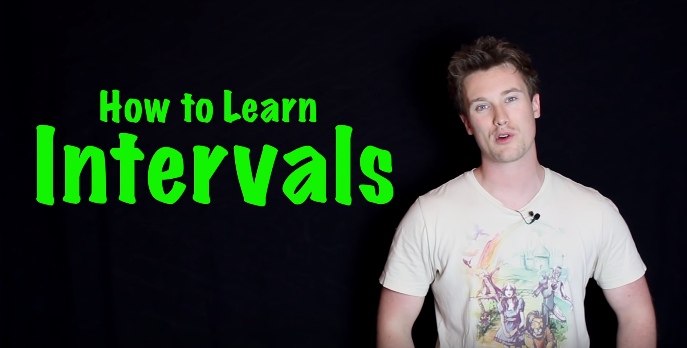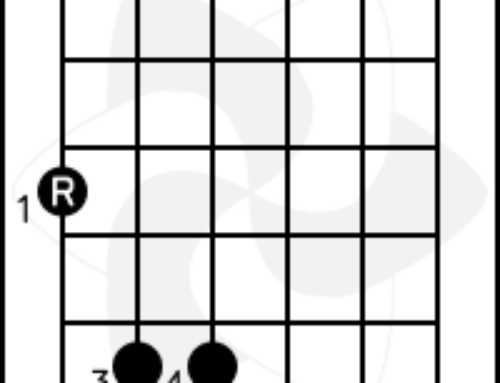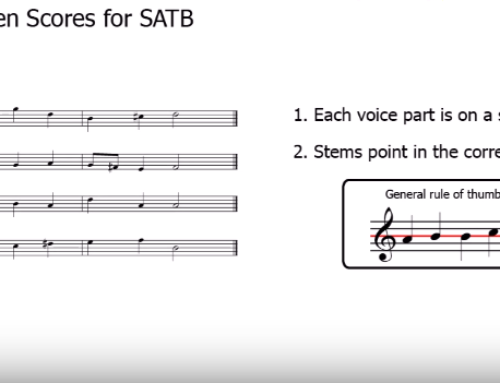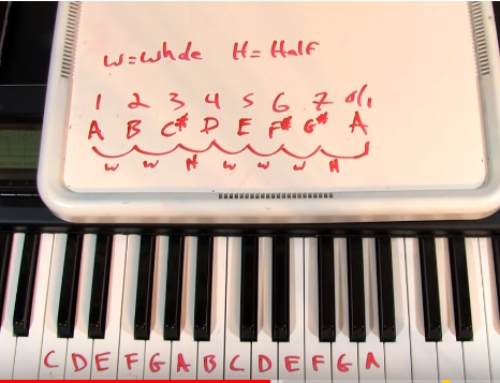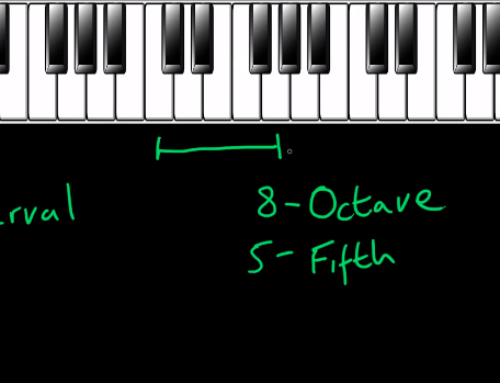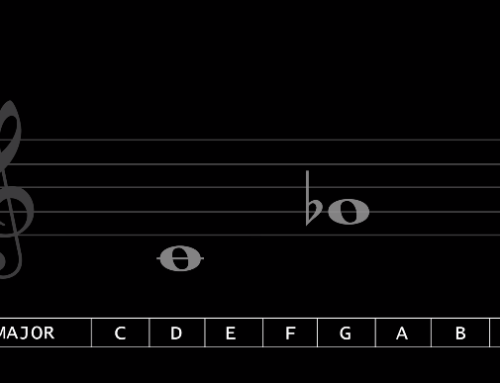How to Understand Musical Intervals – What Are Musical Intervals?
Transcript may be inaccurate in some areas due to software
0:00
everyone. So today we’re looking at the world of intervals. Now, really quick and simple explanation is that let’s say you’re playing your instrument, a guitar, or you’re playing a piano or something like that, and you’re playing one notes. Okay, so that one note is carrying on. And you want to play some more notes on top of that one note that you’re playing. So whenever you’ve got more than one note, or one time playing at the same time, there’s called intervals and as intervals going on, you can have intervals above the first note the applying intervals below intervals mixed in like a chord or something like that. But that’s what intervals are. And really once you start hearing the different interval difference and you start sort of learning your instrument and you learn what notes you’re actually playing as opposed to just where your fingers are going. It’s really really important the sky’s the limit just imagine like a film composer okay a film composer knows that these series of intervals works with these you know series of tempers and these sorts of fields again, to make people cry, we’re going to make people angry. That’s how powerful intervals are don’t think that composers
1:00
You know, composing for huge, big budget film scores, don’t know the interval difference that’s going on and don’t know exactly the sounds that they make, and what emotions that you know, that make people think or make people feel that way. intervals are very, very powerful thing. And we’re going to look today at the intervals in the one octave, I’m going to look at a really good way of how to remember each interval going up, okay, and part two will be looking at intervals going down, but for now, really important that we look at intervals within the first octave. Here we go. Now, I reckon the best way to work at intervals and I’ve done it for years and years, and sooner or later, you know, it sticks into your head, but I think it’s still a really good way to write it down. So grab a pen and paper, a great way of remembering intervals is to write what I’ve written up here. Okay, so you’ve got see and then we’ve written all the different interval names from see up an octave to see so we’ve gone semi time all the way up. Okay. Now if you don’t understand trends and semi times check out this other video because that will really really help you understand.
2:00
This video okay so you’ve written up all the semi tones from see an octave higher up to see okay we’ve chosen shops in this example but you could use flats that’s fine you just have to remember there’s no sharps and flats between an F or between b&c. Now let’s have a look at that first one so first interval is the perfect unison now all of that means is let’s say you’ve got a note playing one particular node and you noted or could be any night let’s have a look at see. Okay so we’ve got a C note playing. And now on top of that see node you’ve got another see note playing it’s within the same octave so it’s not super high. It’s not super low, it’s within the same octave range and you’ve got to see playing oversee. Okay, now depending on what instrument you’re playing, you could still hear a different time. Okay, so if you’re playing on guitar, for example, different strings, you know, and different sort of pickups and where you play things again, to make the tone sort of very so you could be playing the same note in the same octave, but it could actually be on a different string so it’ll be a little bit
3:00
of a time, but that’s what a perfect unison he is. Okay, you’ve got the same note played twice. Okay? So if you can imagine this one note is playing and you’ve got the same note. It’s not higher or lower. It’s the same pitch. It might sound a little bit different in might have a little bit of at a different time. But it’s at the same level. Easy. That’s perfect. unison right. Here we go. Here’s the perfect unison a C note. I’ll play it to begin with
3:25
another scene out on top of that night. And then together
3:36
now into the fun stuff. So now we’re going to have a look at the minor second and going up. The next interval is a semi turn up. So for example, if you have a look at what you’ve written up a C to A C sharp that’s a minor Second. Okay, so that’s the first interval that we’re looking at. Now remember, could be a shot could be D flat, they’re the same note doesn’t matter. Okay, so play
4:00
Together, it can sound quite dissonance. So definitely have a go of playing C and C sharp or just two notes next to each other. Now you can imagine because it’s a semi turn up, it’s just one fret away, and that mana second. The best way to remember I reckon, is thinking of the theme from jaws. Ok, and now we’ll listen to that. Here we go. Here’s a minor second.
4:36
Now the next interval we’re going to look at is a major seconds. Now all that this is is true semi turns up. So a minor second was one semi turn up C to C sharp major second is to several times so you move up again from C sharp to D. So a major second up from C is going to be D and a great way of remembering that he’s happy birthday the first two nights of happiness
5:00
Let’s listen to that. Now it’s time for a major second,
5:18
a little bit of dissonance there.
5:31
Have a look at the notes that we’ve done. So first semi turn away from
5:36
send me
5:37
a second semi turn up. Again, three semi turns is a minor third, and a great way of remembering this is thinking of Greensleeves, or thinking of Oh Canada so really good way to remember that is either of those two songs, but have a listen to yourself to the intervals, play them together, play them apart, and then see Is there any songs that you can think of that the lyrics come to mind or
6:00
The melody comes to mind that uses that minor third into
6:18
the next interval up from the minor third is a major third. Okay, now it’s just one semi time again going up and it’s really important that you understand how we’re doing it and hopefully have written this down because it’ll really help sort of make sense of it all. So major third, a great way of remembering how to remember a major third is Have yourself a merry little Christmas
6:46
together.
6:53
A quick recap.
6:55
Minor second two is a major second then we go up again to a minor
7:00
Then up to a major third, then the next after that is a perfect fourth. That’s the interval. So in terms of doing it from See, it’s see to f that is a perfect forth now great way of remembering the perfect fourth interval is to think about the song Amazing Grace. Let’s have a listen to that interval now. Perfect forth. Oh,
7:30
now the next interval that we’re looking at, okay, it’s gonna be a rented or shop for or it could think of it as a flat five. So this is a bit of a dissonant interval when played together applied separately. One sort of easy way that I remember this interval and sort of how it sounds is the Simpsons the start of The Simpsons theme, June we show them any of you have heard this and this is a good way of remembering that the the shop for all the flat five interval augmented fourth shot fourth or flat five
8:09
Now the next level we’re looking at, you probably may have guessed already is going to be a perfect five. Okay, I perfect fifth from see is see to G and again in a lot of chords, you’re going to find this interval just like the third 135 if you’ve looked at how to make major chords minor or diminished 135 to the fifth is very, very important. And just for a guitarist point of view, fifth is very important. Playing power cords. So to finger chords. Yeah, so all those power cords you can think of all those rock bands, and Metallica. All those guys play a lot of power cords all the time. And all that the the notes are the interval difference is you’ve got your root note. Let’s say See, and you’ve got the fifth night above or the perfect fifth interval above which is G one five. That’s your perfect fit or they’re the notes in a power cord. The great way of remembering the interval difference.
9:00
In a perfect fit, so when you hear the root note, and then a fifth night heard is Twinkle, twinkle little star, or the Star Wars thing. That’s generally how I sort of think of it as the Star Wars thing. Now, let’s have a listen to that. Perfect Fifth. Oh,
9:17
that’s good old power cords. Yeah.
9:23
Um,
9:26
so just a quick recap. Now we’re looking at a semi turn up from a perfect fifth, and we’ve got a minor six. Okay, so just a quick recap. If it’s just the same note played at the same time. Okay, then you’ve got a perfect unison. If it’s a semi turn up, you’ve got a minor second major second minor third sandwich or not from a minor third is a major third, then you’ve got a perfect fourth and you’ve got a sharp fourth or a flat five, then you’ve got a perfect fit. Semi turnout from a perfect fit is a minus six. And that’s what we’re looking at now. So a minus six up from C is going to be
10:00
shop or a flat make sure you’re doing this all with a piece of paper or really really helped to understand it and just to get stuck in your head as well now some still remember the mana six it’s a bit tricky maybe you guys know some better ones that honor but I really use the song Welcome to count of aloe black Orpheus that’s the starting notes of that song really helped me remember the minus six here’s a minus six
10:31
now semi turned out from a minus six interval remember the minus 16 see is G sharp or a flat semi turn up from that is going to be of course a good stuff so a major six interval in see is see going up to a the way that I remember the interval difference will the way that I hear the interval difference of a major city is to think of my body lies over the ocean or you can also think of the a train that’s another good one. Remember all these will be in the just
11:00
Description below. Let’s hear the interval difference of a major sixth, which is see to a major six.
11:13
Now the next interval up from a major six is a minor seventh. So i minus seven up from a C note in this case is going to be a flat B so a B notes or a B flat or you can think of it as an A sharp same night. But that’s how many semi times it is. And that’s a minor seventh. Now the way that I remember the interval difference minor seven is from the West Side Story song somewhere. That’s how I think of it. Now remember, once you’ve sort of learned this interval and once you’ve been playing and on your instruments, have a listen See if you can find some other songs that are more relevant to you that use this interval. So that’s a minor seven foot zero minus seven
11:59
together.
12:01
We’re almost there to intervals to go. So well done value on Good job guys. Now if you can remember the minor seventh being B flat or a sharp, what’s a semi turn up the octave from that? It’s be okay. So a major seventh in this case and see is from see up to be major seven. So from a seat all the way up to be
12:28
pretty ugly. You can hear it just wants to resolve. Yeah.
12:36
Okay, well done, guys. So you’ve made it all this way through. So the last interval we’re looking at is the perfect octave. Now perfect octave. All that means is we’ve started with see, okay, we’ve moved up all these different semi tones. As you can see, we’ve moved up all those semi tones and we’re finishing on another see note. Okay, so same note C and C, but it’s an octave higher or you’ve gone all those things.
13:00
Many times up and that’s what’s called a perfect octave, good riders, perfect octave, you can rotted as p eight, just as long as you know that it’s a perfect octave, the perfect octave, a good way to remember it is thinking of I’m singing in the rain. Okay, go back and have a listen to that song list. first couple notes of the the lyrics is the perfect octave. And let’s hear that now. So it’s going from one see again, you’ve gone all those different steps up to the other. See, well done, guys. You’ve made it. Let’s hear it. Now. Finally, perfect
13:31
and together.
13:37
Well done, guys. You’ve made it to the end. Good job. Now intervals is so important once you can sort of start practicing that if you hear the same note and it’s going to be a perfect unison if you’re a semi turn up and it sounds a bit like a jaws theme. A minor second than up again a major second minor third major third perfect fourth shot fourth or flat five, perfect fifth minus six maybe.
14:00
Just six minus seven major seventh. And then the perfect octave. Again, once you sort of start memorizing those names, and just practicing those intervals, you’d be surprised to be listening to attune and you’ll think oh, that’s a bit of a dissonant sort of melody. It sounds really close to mine a second because when I play those notes on my instrument, it reminds me of jaws once you sort of start putting those notes into references that you understand and you can instantly remember you’d be surprised how far this sort of stuff will take you and this theory and this practical theory is really the basis of everything we’re going to do because when we’re going to be looking at soloing, a when we’re going to be looking at playing all the chords, you know, in particular keys, major mana, diminished all that stuff. When we look at doing that stuff, I’m always going to be referring to intervals. So I’m going to say, Okay, this court is major made up of a major third and it’s made up of a perfect fit. And if you didn’t watch this video, you’re not going to understand so make sure that all this stuff makes sense. And the best way of practicing this stuff is to do what we’ve done to pick a key or to
15:00
an octave that you’re going to do it in to write the first note. So we’ve done See, right all the way up going up in semi tones till you get up an octave and just work out the interval difference. Okay, work out what’s the minor second? What’s the major third? What’s the perfect fit everything like that. Now we’re gonna have more videos in more sort of productive ways I can tell you how to memorize it all. But just writing out for now is really, really good. And just listening to all those examples and trying to find your own examples as well. Well done, guys. It’s really important that you’ve made it through this video. You’ve done a great job. See you again next time. Bye.


